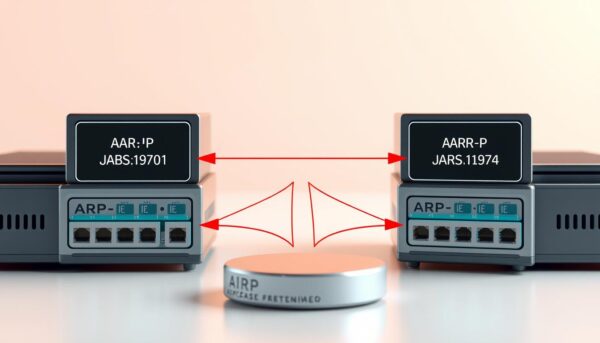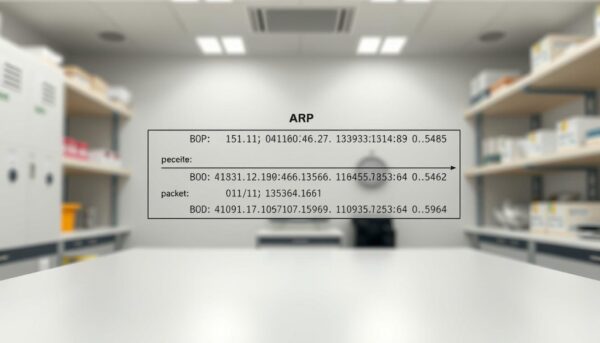✅ Last checked on
What if your computer couldn’t find its neighbor on the same network? Behind every click, email, or video stream lies a hidden translator ensuring devices “speak” the same language. This unsung hero? The Address Resolution Protocol.
Devices on a network rely on two types of addresses: logical IPs and physical MACs. While IP addresses identify devices globally, MAC addresses pinpoint hardware locally. Without a system to connect these, your data would wander endlessly like a lost package.
Here’s how it works. When your device needs to send data, it broadcasts a request across the network. The target device responds with its hardware address, creating a temporary link between IP and MAC. This process, standardized in 1982 (RFC 826), operates at the data link layer—bridging software and hardware communication.
Though newer protocols like IPv6’s Neighbor Discovery exist, this method remains vital for Ethernet-based networks. It balances simplicity with efficiency, maintaining seamless connections in homes and offices worldwide.
Key Takeaways
- Translates IP addresses to MAC addresses for local network communication
- Uses broadcast requests and direct replies to map devices
- Operates at the data link layer of network architecture
- Maintains dynamic cache tables to reduce repeated requests
- Critical for Ethernet networks despite newer alternatives
- Vulnerable to spoofing attacks without proper safeguards
Understanding ARP Protocol
Imagine sending a letter without knowing your neighbor’s apartment number. The Address Resolution Protocol solves this digital dilemma by linking temporary IP addresses to permanent hardware identifiers. This system acts like a phonebook for local networks, ensuring devices can communicate efficiently.
What Is Address Resolution?
When your device needs to find another computer on the same network, it sends a broadcast message asking, “Who has this IP address?” The target machine responds with its MAC address—a unique hardware identifier burned into its network card. This process uses specific packet components:
| Field | Description | Example |
|---|---|---|
| Hardware Type | Network technology used | Ethernet (1) |
| Protocol Type | Address format | IPv4 (0x0800) |
| Operation Code | Request or reply | 1 (request), 2 (reply) |
Historical Development and Standards
David Plummer introduced this method in 1982 through RFC 826. Originally designed for Ethernet networks, it later adapted to technologies like FDDI. Updates like RFC 5227 (2008) added safeguards against address conflicts.
Modern networks use a cache table to remember recent matches. This temporary storage reduces network chatter—entries typically expire after 2-20 minutes depending on system settings. You’ve likely benefited from this invisible process every time you streamed a video or loaded a webpage.
ARP and Its Role in Networking
Local networks rely on a hidden directory to connect devices. This system bridges two critical layers: the network layer (IP addresses) and the data link layer (MAC addresses). Without this link, your computer couldn’t deliver files to the printer or stream videos to your smart TV.

Here’s how it works in practice. When you send data, your device first checks its local cache for the recipient’s hardware identifier. If the MAC address isn’t stored, a broadcast message queries all devices on the network. The correct host responds, updating the cache for future requests.
| OSI Layer | Address Type | Function |
|---|---|---|
| Network (Layer 3) | IPv4 | Logical device identification |
| Data Link (Layer 2) | MAC | Physical hardware communication |
Caching is the secret to efficiency. Temporary entries prevent constant broadcasts, reducing network traffic by up to 40% in busy environments. Entries expire quickly—usually within minutes—to adapt to changing connections.
This protocol shines in router-free zones. Devices on the same Ethernet network use it to communicate directly, like coworkers passing notes in an office. However, its trust-based design creates risks. Attackers can poison caches by sending fake hardware addresses, redirecting traffic without detection.
Despite vulnerabilities, the system remains essential. From loading websites to sharing files, it ensures devices speak the same language locally. Modern networks add security layers, but the core process stays unchanged since the 1980s.
Deep Dive into ARP Packet Structure and Operations
Every network conversation begins with a digital handshake. At its core lies a 28-byte packet that acts like a translator’s dictionary. This structure bridges logical IP addresses with physical hardware identifiers through carefully designed fields.

Packet Format and Structure Details
The packet header works like an instruction manual. Here’s what each section does:
| Field | Purpose | Example Value |
|---|---|---|
| Hardware Type | Network medium (Ethernet, Wi-Fi) | 1 (Ethernet) |
| Protocol Type | Address format | 0x0800 (IPv4) |
| Operation Code | Request (1) or Reply (2) | Broadcast/Unicast |
Hardware Address Length (HLEN) and Protocol Address Length (PLEN) define MAC and IP address sizes. For Ethernet/IPv4, these are 6 and 4 bytes respectively.
ARP Request, Reply, and Announcement Mechanisms
Requests flood the network like a town crier’s shout. Your device broadcasts “Who has 192.168.1.5?” using EtherType 0x0806. The target responds directly with its MAC address in a unicast reply.
Gratuitous announcements work differently. They’re unsolicited updates sent when:
- A device changes its IP-MAC pairing
- Network interfaces reboot
- Duplicate IP detection is needed (RFC 5227)
These packets look like replies but target their own IP. Tools like Wireshark flag them as “gratuitous ARP” in captures. This mechanism keeps traditional ARP processes efficient across Ethernet and legacy systems like token ring.
Managing ARP Cache and Practical Usage
Your network’s hidden phonebook needs regular maintenance to stay accurate. The address resolution protocol cache stores recent IP-to-MAC matches, but manual oversight prevents errors and security risks. Let’s explore tools and techniques to manage this critical resource.
Using Command Line Tools for ARP Management
View your device’s current mappings with arp -a in Windows or arp -n in Linux. These commands reveal dynamic entries learned through network requests and static ones you’ve manually added. For example:
| Command | Function | Example |
|---|---|---|
| arp -s | Add static entry | arp -s 192.168.1.5 ab:cd:ef:12:34:56 |
| arp -d | Delete entry | arp -d 192.168.1.5 |
| arp -v | Show details | Displays interface-specific data |
Deleting outdated entries resolves connectivity issues caused by IP conflicts. Always specify the interface address when managing multi-homed systems.
Static vs Dynamic ARP Entries
Dynamic entries expire automatically—usually within 10 minutes. Static mappings persist until reboot or manual removal. Use permanent entries for critical devices like servers or network expansion hubs to prevent spoofing attacks.
| Type | Lifespan | Security |
|---|---|---|
| Dynamic | Temporary | Vulnerable to fake replies |
| Static | Persistent | Blocks unauthorized changes |
For advanced protection, combine static entries with ARP table monitoring tools. This dual approach secures local communications while maintaining network flexibility.
Conclusion
Behind every seamless network interaction lies a critical translation process. The address resolution protocol bridges software logic and hardware reality, letting devices convert IP identifiers into physical MAC addresses. This foundational layer of communication ensures your printer receives documents and streaming devices get video packets—without requiring manual address books.
Managing these mappings efficiently requires attention. Tools like command-line entries let you lock critical hardware addresses or clear outdated data. Static configurations protect routers and servers from spoofing attacks, while dynamic caches adapt to mobile devices joining Wi-Fi networks. Regular maintenance keeps this system running smoothly, balancing speed with security.
Though newer protocols emerge, this method remains vital for local networks. Its simple request-reply structure and temporary caching strike an enduring balance between flexibility and efficiency. For those managing home setups or enterprise systems, understanding these mechanics helps troubleshoot connectivity issues and safeguard data flows. Review previous sections to master practical applications of this invisible yet indispensable networking tool.